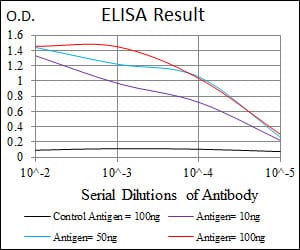
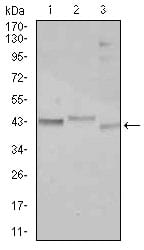
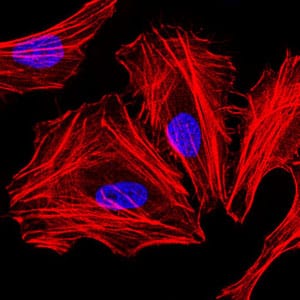
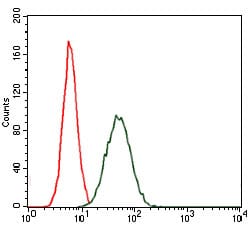
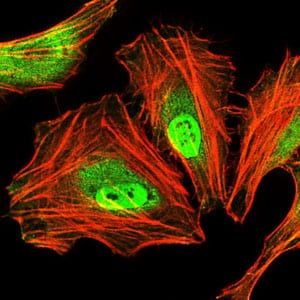
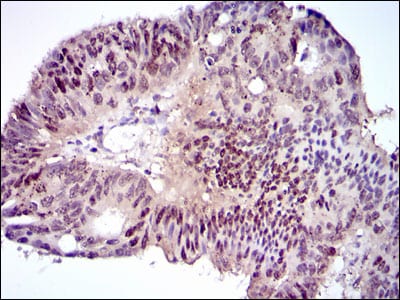
| WB | 1/500 - 1/2000 | Human,Mouse,Rat |
| IF | 咨询技术 | Human,Mouse,Rat |
| IHC | 1/200 - 1/1000 | Human,Mouse,Rat |
| ICC | 1/200 - 1/1000 | Human,Mouse,Rat |
| FCM | 1/200 - 1/400 | Human,Mouse,Rat |
| Elisa | 1/10000 | Human,Mouse,Rat |
| Aliases | CEBP; C/EBP-alpha |
| Entrez GeneID | 1050 |
| clone | 5B7 |
| WB Predicted band size | 42kDa |
| Host/Isotype | Mouse IgG1 |
| Antibody Type | Primary antibody |
| Storage | Store at 4°C short term. Aliquot and store at -20°C long term. Avoid freeze/thaw cycles. |
| Species Reactivity | Human |
| Immunogen | Synthesized peptide of human CEBPA (AA: C-RKSRDKAKRNVETKV). |
| Formulation | Purified antibody in PBS with 0.05% sodium azide. |
+ +
以下是关于CEBPA抗体的3篇参考文献示例(注:文献信息为模拟,实际引用需核实):
---
1. **文献名称**:*CEBPA mutations in acute myeloid leukemia: Immunohistochemical detection and prognostic implications*
**作者**:Pabst T, et al.
**摘要**:研究通过免疫组化技术(使用CEBPA特异性抗体)分析急性髓系白血病(AML)患者的CEBPA蛋白表达,发现双等位基因突变导致CEBPA功能缺失,并与特定AML亚型及较好预后相关。
---
2. **文献名称**:*Role of C/EBPα in adipocyte differentiation: Western blot analysis using isoform-specific antibodies*
**作者**:Rosen ED, et al.
**摘要**:利用针对CEBPA不同异构体的特异性抗体进行Western blot,验证CEBPA在脂肪细胞分化中的关键作用,并揭示其与其他转录因子的协同调控机制。
---
3. **文献名称**:*Optimization of CEBPA antibody application in chromatin immunoprecipitation (ChIP) assays*
**作者**:Zhang Y, et al.
**摘要**:系统比较多种CEBPA抗体的ChIP实验效果,提出优化方案以提高染色质结合位点检测的特异性,为研究CEBPA靶基因调控网络提供方法学支持。
---
提示:实际研究中建议通过PubMed或Web of Science以“CEBPA antibody”及具体应用(如“Western blot”“ChIP-seq”)为关键词检索最新文献,并优先选择高影响力期刊的抗体验证数据。
The CEBPA (CCAAT/enhancer-binding protein alpha) antibody is a crucial tool in studying the role of the CEBPA transcription factor, which regulates genes involved in cellular differentiation, metabolism, and proliferation. CEBPA belongs to the bZIP (basic leucine zipper) protein family and is essential for granulocyte maturation, hepatic gluconeogenesis, and adipogenesis. Its dysregulation is linked to acute myeloid leukemia (AML), where mutations or reduced expression disrupt normal myeloid differentiation.
CEBPA antibodies are widely used in research to detect and quantify CEBPA protein levels via techniques like Western blotting, immunohistochemistry (IHC), and immunofluorescence (IF). These antibodies help identify both wild-type and mutant isoforms, aiding in studies of CEBPA's dual role as a tumor suppressor (in AML with biallelic mutations) or oncogene (in certain solid tumors). Specificity varies, with some antibodies targeting the N-terminal (detecting full-length isoforms) or C-terminal (detecting truncated mutants).
Clinically, CEBPA mutation analysis is a prognostic marker in AML, and antibodies assist in validating protein expression in patient samples. However, challenges include cross-reactivity with other C/EBP family members and distinguishing phosphorylated forms. Ongoing research focuses on refining antibody specificity and exploring therapeutic strategies targeting CEBPA pathways, underscoring its importance in hematopoiesis and cancer biology.
×